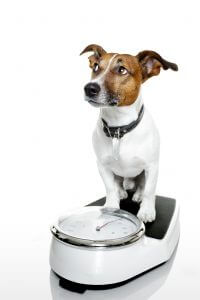1 June 2016
Experts say that around 25-40% of modern dogs are obese or likely to become obese. Overweight dogs have a greater chance of having joint problems. Unnecessary stress is put on vital organs such as their hearts, lungs, liver and kidneys and makes them prone to injury and illness.
How to tell if your dog is overweight;
- Look at your dog’s silhouette from above. There should be a defined waist, and you should be able to tell where the ribs end and the hips begin. If this is not the case it is a sign that your dog may be carrying too much weight.
- Check the ribs. There should be a thin layer of fat but you should still be able to feel them. Do the same with legs, spine, shoulders and hips.
- Monitor the dogs breathing. If they breathe heavily after no exertion and have a hard time recovering from a short walk or play session, this may be a sign for concern.
- Look online by breed, age and size to find your dog’s ideal weight.
How to weigh your dog at home;
- Weigh yourself and note down the number.
- Pick up your dog.
- Step back on to the scale and record the combined weight of you and your dog.
- Subtract your weight from the combined weight.
You now know your dog’s weight. Consult your vet to find out if this is a healthy weight for your dog.
The main reason why dogs are overweight is because of the simple reason that they are eating too much food. Most dog owners are not sure how many calories they need to maintain a healthy weight for their dogs. Small dogs that are not very active need as few as 185 to 370 calories a day. A dog weighing between 67 and 88 pounds may need between 1,100 and 1,700 calories a day.
Overly generous portions, too many in-between meal time snacks and table scraps should all be avoided if possible. If your dog is prone to overeating, selective feeding should be stopped (if the dog has food down 24/7) as they tend to eat when they are bored, not hungry. Try to feed in smaller more regular meals and pick up any leftovers after 30 minutes.
When choosing food, try to keep to low calorie content. Our Turkey Senior & Weight Control range has a decreased amount of calories but slightly higher protein. This is the prevent muscle wastage that is often seen in dieting dogs. A range of therapeutic herbs is specifically chosen to support mobility and organ function.
Genetics plays a part in your dog’s tendency to gain weight, too. Some breeds are just more prone to putting on weight than others. The breeds more inclined to be obese include American Cocker Spaniels, Basset Hounds, Beagles, Cairn Terriers, Cavalier King Charles Spaniels, Dachshunds, Labrador Retrievers, Norwegian Elkhounds, Rough Collies and Shetland Sheepdogs.
Modern dogs do not get as much exercise as they need. Depending on their breed, age and size, a good goal is 20-60 minutes of activity each day. Often dogs are confined indoors or in small gardens where they simply cannot get the exercise they need.
Dogs that have been spayed or castrated are prone to weight gain. Neutering affects energy expenditure and slows down metabolism.
Cushing’s disease can be recognized by weight gain, increased hunger and thirst, panting, a pot-bellied appearance and hair loss. Hypothyroidism is another that has symptoms including weight gain, lethargy, hair loss, weakness, infection and less tolerance for exercise. If you suspect either of these it is best to visit your vet and find out if there is an underlying cause for your dog being overweight.
Your vet can not only diagnose the cause of your dog’s weight gain, but also help you form a realistic, safe weight loss plan for your pet. Crash diets are as bad for your dog as they are for you. Weight takes time to put on, so time is needed to safely take it off. Your vet can help you to figure out the most effective way to do that.
